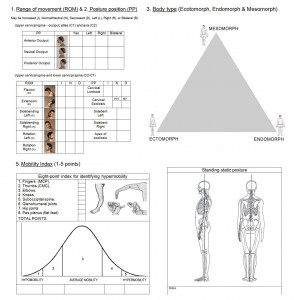Assessment Prescriptive Stretching Program

The Assessment Prescriptive Stretching Program (APSP) is an appraisal of joint mobility and muscle flexibility, the results of which contribute towards the creation of a personalised set of stretching exercises. The assessment findings combine with important personal needs to determine which stretches are best suited to the individual.
The stretching program is put together from the 200 stretches found in the book Safe Stretch – a comprehensive guide to stretching which takes into account the similarities and differences between people.
The Assessment Prescriptive Stretching Program is based on seven parameters:
- Range of joint movement (ROM)
- Posture position (PP)
- Body type (Ectomorph/Endomorph/Mesomorph)
- Age
- Mobility index (1-5 points)
- History (Injury/Surgery/Pathology/Psychology)
- Needs (Sports/Work/Activities)
Everyone is different and a ‘one size fits all’ approach to stretching can be counter-productive or sometimes even dangerous. Individual differences in posture and flexibility exist because of genetics and lifestyle factors, our age, emotions, and history of injury. The Assessment Prescriptive Stretching Program is an evaluation system which takes these differences into account and provides a series of stretching exercises from the Safe Stretch book which are tailored to your unique physical characteristics and needs.
After the assessment you will be given a set of stretches that are safe to do and you will be given instruction on how to do them. They will take into account your flexibility, posture, body type, and age and if there is disease or dysfunction present. They will also take into account your needs – you work requirement, hobbies and if you do a particular sport.
A huge range of genetically determined variation exists in the shape of human beings, from short to tall, and from stocky to thin. The size and shape of the human body, its bones and joints, and also its muscles and ligaments, are important because they influence range of movement and flexibility. Another genetic factor influencing mobility is the elasticity of the ligaments and joint capsules.

A range of flexibility exists across all human beings, with very flexible or hypermobile people at one end of the spectrum and very stiff or hypomobile people at the other end, and following a typical bell curve pattern most people are in the middle with average mobility. Lifestyle factors also influence mobility. Sedentary activities such as desk work, driving a car, or sitting watching TV affect our body – muscles become weaker and shorter, ligaments become less elastic and there are changes within the joints and they get stiffer. Injuries to muscles or ligaments can lead to scaring and adhesion formation, which are fibrous tissues that are not as elastic as the original tissue. If the body retains these tissues and the area will be weaker and less flexible. Anxiety, depression and other mental issues can increase muscle tension, which can also lead to increased joint stiffness.
The Assessment Prescriptive Stretching Program takes these factors into account and recommends the most appropriate stretches and advises on the correct execution of the stretching technique, according to the situation.
Two 40 minute visits are required to assess and prescribe a stretching programme tailored to your unique body structure, posture and needs. These are done by Rowland Benjamin the author of Safe Stretch who is also a manual therapist and registered Osteopath with over 30 years experience. In his practice Rowland treats muscle and joint problems, such as chronic or intermittent pain with hands-on manipulation. He uses stretching in his practice as well as giving advice on work habits, posture, stress and other exercise techniques because he knows that they are an important component in the overall treatment, and may make the difference in preventing the same problem from returning.
I invite you to consider taking a proactive step in body health by purchasing Safe Stretch and booking in for the assessment at my clinic in Bridgetown, Western Australia. Details on bookings, location maps and other information for the assessment can be found on my website www.rowlandbenjamin.com
Safe Stretch is available for AU$90 plus postage. The book combined with the assessment is $290. For all orders of Safe Stretch or interest in the assessment please fill out the contact form
Learn to be an APSP evaluator
You can become an Assessment Prescriptive Stretching Program Evaluator. Training involves 200 hours of anatomy, biomechanics and stretching. At the end of the training you will be able to assess range of joint movement and posture, categorise according to body type, age and mobility index, take a history and calculate the stretching needs of an individual.
With the information gathered from the assessment you will then be able to prescribe a safe effective stretching program.



